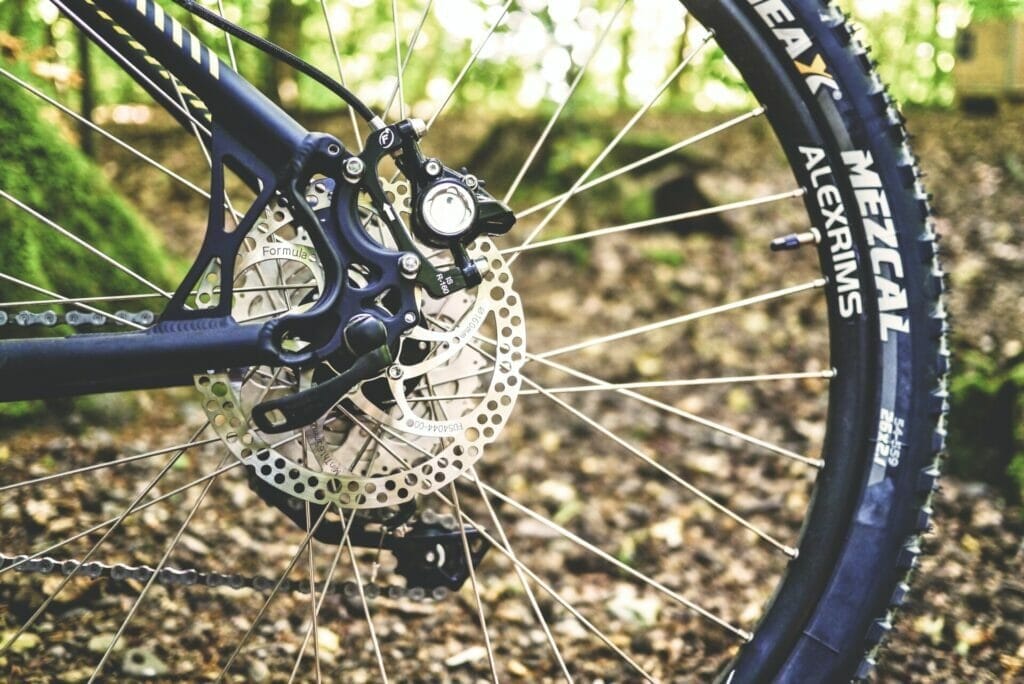Contents
- 1 What Is The Best Way To Measure A Bicycle Tire?
- 1.1 How Do You Measure Bicycle Tire Size?
- 1.2 How to Measure the Bike Tire Circumference
- 1.3 The standard method
- 1.4 The ISO Standardization method
- 1.5 Check Bike’s Manual
- 1.6 Step
- 1.7 Step Diameter
- 1.8 Step Width
- 1.9 Combining the Measurements
- 1.10 Common Bike Tire Sizes
- 1.11 Road Bike Tire Sizes
- 1.12 Mountain Bike Tire Sizes
- 1.13 Cyclocross Tire Sizes
- 1.14 Gravel Tire Sizes
- 1.15 Track Tire Sizes
- 1.16 Last words
What Is The Best Way To Measure A Bicycle Tire?
To measure the size of a bike tire, you will need a flexible tape measure and a pen. Measure from the center of the rim to the outside of the tire. The distance should be equal to the inside diameter of the rim.
The width of your tires is measured at its widest point. This is usually taken right in front of the rear wheel, where it meets the frame. If you are unsure about this location, take a few measurements until you find the one that feels best for you.
How Do You Measure Bicycle Tire Size?

Tire sizing is usually given in two dimensions:
diameter (the outermost circumference) and width (the distance across the widest part).
Mountain bikes use a metric system based on millimeters, while road bikes use inches.
A typical mountain bike tire size is 29×2.25″ or 29 mm × 2.25 cm.
Road bike tires are 700×25 mm or 700 mm × 25 mm.
Tires are usually made to fit rims.
A 700c tire will fit a 700c rim.
A 29″ tire will fit a 29″ rim.
Some obsolete or unusual sizes can also be misleading. Tire widths are mostly approximations. Rim pressures can affect bike sizing.
Tire sizes are measured in both metric and imperial units. For example, a tire size of 225/50R15 means that the tire is 225mm wide and 50mm tall. In addition, this tire is 15 inches wide.
How to Measure the Bike Tire Circumference
You can use a string to measure the circumference of your bicycle tires. Please measure the length of the string by wrapping it around the outer edge of the tire. Then cut off the string at the point where it meets the straight line.
Your bike tire is 2.5 inches wide.
The standard method
A bike should be kept upright using either a wall or a kickstand. Measurements can be taken without the bike tipping over. Retractable metal tape measures are more durable than plastic ones.
A tire’s diameter is equal to twice the distance between the ground and the wheel’s center.
Tire widths vary greatly depending on the intended use of the tires. Tread widths vary widely depending on the intended terrain. A wider tread guarantees a smoother, faster ride, but a narrower tread ensures a smoother, slower ride.
Tire size is always given as Diameter x 2 + Breadth.
The ISO Standardization method
Your tire size is 24mm.
Tire size must be measured from the center of the wheel to the inside edge of the tire. Diameter is found by multiplying measurement times 2. This method is the most accurate.
Tire width is measured by going from one side to the tire’s opposite side.
Check Bike’s Manual
Wheel sizes are usually listed in the specifications manual for the bike. If this is not true, contact the bike store or retailer’s website to get more information about the bike’s specifications.
Step
The measurements must now be combined. The diameter comes first in a standard bike tire size, followed by the width.
So, if your bike wheel diameter was 26inches and the width came out to 22inches, the printed bike wheel measuring would be 26×22.2.”
Step Diameter
Bicycle wheels are made up of spokes. A hub connects spokes. Hubs are attached to the axle. Axles connect the front and back wheel. Wheels are usually made out of aluminum or steel.
Tire sizes are usually whole numbers. So, it would help if you rounded up or down to the nearest whole number. For example, if your tire size is 25.8, the actual diameter is 26 inches.
Step Width
Tire width is measured by measuring tape across the tire’s tread. Usually, the width is measured from one side of the tire to the other.
Combining the Measurements
The traditional representation of bike size is placing the diameter first, then the width. The ISO representation places the width first, then the diameter.
You should measure your bicycle wheel size every time you change your tires. This will ensure that your speedometer, GPS, or other devices are calibrated correctly.
You should measure the diameter of your bicycle tire. Then, you can calculate the circumference by multiplying the diameter by pi (π).
You can easily know the bike circumference by multiplying the diameter by 3.14. The circumference of a 29-inch tire is reached by multiplying the diameter by 2.71. Another formula for calculating circumference is C 2r or πr^2, Where r is the Radius, the figure you get when you double the distance.
Common Bike Tire Sizes
Tire sizes use/discipline use/ size designations.
700C x 23mm – 32 mm Road/ Track
622. 700C x 35mm – 50 mm Gravel and Mixed Surface
622. 650B x 23mm – 25 mm Small road bikes
584.650B x 45mm – 50 mm Grail and Bikepacking
584.26″ x2. 1″–2. 3″ Cross-Country MTBs 559.
Note:
- The first two numbers represent the size of the tire.
- The second number describes the width of the bike wheel size.
- The third number represents the height of the tire.
- The fourth number represents the width of a wheel.
- The fifth number represents the width of an enduro or downhill bike.
- The sixth number represents the width of cross-country bikes.
This tire is suitable for 29″ x 2.3″ or 2.4″ – 2.6″ bikes.
Road Bike Tire Sizes

Road bikes are designed to work well with wide tires. Some frames are limited by the size of the tires they can accept. Check your frame’s specifications before buying a bigger tire.
650b and 650c are the most popular sizes for road bike tires.
There are also other road tire sizes, such as 700x23C and 700x25C.
Tubulars are permanent, while clinchers are removable.
Clinchers are more common than tubular. Clinchers are designed to sit inside a walled rim.
Tubulars are designed to be glued into a rim. Tubulars use the same sizing standards as clinchers.
Mountain Bike Tire Sizes
Current mountain bike tires are measured in inches and offered 3 non- interchangeable bike tire diameters based on common mountain bike wheel sizes.
A majority of mountain bikes on the market have 29″ wheels and tires.
Next, 27.5″ setups are preferred by light riders who like smaller, more maneuverable wheels.
Additionally, 26″ wheels and tires were once the standard size but are now found mostly on entry-level and kids’ bikes.
In addition to each diameter, tires are available in a wide range of widths, which cyclists select for the specifics of the discipline and terrain.
Cross country racers usually choose relatively narrow tires ranging from 1 9″ to 2 25″.
Normally, trail, all-mountain, and enduro bikes have tires between 225mm and 24″ in width, and downhill bikes have tires between 24″ and 26″.
Fat bike tires are mounted on a special wheel rim and push the limits even further, sometimes measuring up to 5″ in width.
The specifics of tire selection are carefully considered by mountain bicyclists, with racers often selecting tires based on the conditions of the course and weather.
Mountain bikes use 700c rims, but road bikes use 650b rims. So if you buy a set of mountain bike tires, you’ll need a new rim too.
Cyclocross Tire Sizes
Cyclocross tires are usually 700c sized. Most cyclocross racers use tubular tires, but some use tubeless tires.
Tubeless tires are becoming more popular than tubular. At UCI-sanctioned events, you must use a tire that fits within the specified limits. At non-UCI sanctioned events, you may use any bike tire size tire you want.
Gravel Tire Sizes
Gravel bikes were originally repurposed cyclocross bikes. Tire options have greatly expanded with dedicated gravel equipment, including 700c and 650b wheels.
Most new gravel bikes are equipped with clearance for tires ranging up 42-45mm wide. Most gravel riders use tubeless tires.
Gravel bikes are faster than road bikes because they have narrow tires and less tread. They are also more efficient on the pavement.
Road bikes are slower than gravel bikes because they have wider tires and more tread. They are better suited for rough terrain.
Track Tire Sizes
Track bikes use 700c wheels, and road cyclists use them. However, track bicycles use hard, narrow tires while road bicycles use soft, wide tires.
This makes them different from each other. Track bikes are designed for speed and efficiency. Road bikes are designed for comfort and control.
Last words
The best advice I can give is to go to your local bicycle shop or online retailer and ask what sizes fit your bike. If you’re not sure what size fits your bike, it’s always good to err on the side of caution and get a larger size.
If you’re looking for a specific type of tire, many resources are out there.

